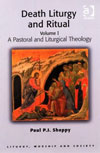Liturgy Newsletter — Reviews
November 2004
Death Liturgy and Ritual
Volume I: A Pastoral and Liturgical Theology
Volume II: A Commentary of Liturgical Texts
Paul P.J. Sheppy. Aldershot: Ashgate, 2004.

The importance of births, marriages and deaths as pastoral opportunities for the ministering of the Gospel to a largely unchurched, and variously believing nation is acknowledged by all the churches. Paul Sheppy‘s two volumes provide an opportunity to reflect on how effectively the churches might be doing with regard to one of those three occasions — funerals.
He observes that an enormous challenge faces the ministers of funeral liturgy, not only in contemporary Britain but in much of the Western world. Commonly the only liturgy for our dead takes place in a twenty minute slot at the local crematorium. There may be other domestic rituals of prayer and remembrance before or after but often the content of these relies on the imagination of the family or the fashion of the times. Regularly the only church contact is in the twenty minute slot.
And of that twenty minutes the family will have all sorts of expectations, often not shared with the minister. The minister might expect something of salvation to feature, an exploration of what has/is happening to the deceased, and of the bereavement of those present in the light of the Paschal Mystery. But as Sheppy demonstrates so well, and as most pastoral ministers will know, the mourners will want a celebration of the life of the deceased. The minister may well be asked: ‘Try not to go on too long, we‘re not very religious.‘
Is it any wonder that all concerned can end up dissatisfied with funeral liturgy (or is it funeral ‘liturgy‘) when the content and form of the Christian liturgical tradition is very largely opaque to mourners and when what has meaning for them is not infrequently inimical to Christian faith and values. But ministers are loath to turn people away even when there is no faith present — and not only for fear of losing an opportunity for evangelisation, but as Sheppy says, time is short, where else can they go, simple humanity compels generosity of response.

But if we are to respond well, says Sheppy we must better understand where our contemporaries are coming from in terms of their understanding of the human person, of the nature of death, of the nature of life. As he says, a Christian‘s faith in the resurrection of the body was guaranteed by the resurrection of Christ, and this as a work of the Father, not an inevitability. He draws powerfully on the mystery of Christ‘s descent to the dead ‘an activity of God which leads to salvation — even in the face of human judgement (p81). That saving action of God, of which both the dead and the living are in need, is what a Christian funeral is to announce and minister.
In volume I Sheppy establishes what he thinks are the issues concerning what is life and death, and the nature of the human person in contemporary thought, and what more is revealed about these things by the mystery of Christ‘s dying and rising. He writes clearly and never afraid of the personal comment seeks to actively engage the reader in discussion and reflection.
In volume II he moves on to an analysis and critique of the funeral rites of (mostly) the churches of the West. Almost inevitably much of this volume is taken up with description of the various rites, and frankly much of this is somewhat tedious and repetitive. But it is worth sticking at it, to benefit from Sheppy‘s critical commentary. He‘s very effective at demonstrating how the various rites do what they do, how their theology and anthropology is conveyed, what their focus is. In all this he is very ready to express his own opinion, and sometimes very critical and provocative that opinion is too. But, agree or disagree with it — and sometimes I did disagree, for example with some of his comments on the Roman Catholic ‘Order of Christian Funerals‘ — I found I benefited from the argument! There is a unusual degree of thoughtfulness here, and a good deal of pastoral wisdom.
Allen Morris
Voices from the Valley
Hymn Texts with Biblical Reflections
Genevieve Glen OSB. OCP Publications 2003

In my experience congregations can be funny about singing hymns. Part of me wants to believe that, at Mass, this is an expression of discomfort about using hymns in the Roman Rite. I don‘t think this is as far-fetched as it sounds particularly when combined with my second guess. They do not see the point of singing this particular hymn at this particular moment. It does not connect. All those hours searching the right hymn that subtly brings out the themes of the Lectionary — wasted. All those allusions to scripture — lost.
This is a roundabout way of saying much as I have enjoyed looking at Genevieve Glen‘s well-crafted hymn texts I cannot imagine singing many of them on Sunday morning. The texts brim with scriptural allusion — the average text seems to pick 5—6 passages, which are noted. But what is less obvious, and not noted, is the occasions for which the texts were written. I admit that I appreciate those notes that tell me this what for this group of people, in this place, for this reason. Yes, there are commentaries noting how the scripture shapes the text but they are commentaries rather than reflections.
These are well-made texts. The language is direct, the syntax never awkward and the rhymes unforced. Often there is a pleasing structure to the text with either repeated phrases or patterns.
The book is arranged with the hymn texts first with commentary in a 2 page spread followed by musical settings with the whole text underlaid as is the American preference. The texts are given in alphabetical order. Though I appreciate this means that each text stands by itself I wondered if there might have been an advantage grouping the texts around themes such as Advent. This is, in some ways, a collection of poetry and the arrangement of texts can enlighten as much as the texts themselves. All the hymn tunes are old — or more precisely out of copyright. Only once in the text section is it mentioned that a text was written for a particular tune and that one which is in copyright so omitted. There is only one text which seems to me to be wedded to its tune: Arise! Stand on the height! to the tune of Darwell‘s 148th. Most others seem non-committal, some are unhappy marriages. Compassion walks the city street to ‘St Patrick‘s Breastplate‘ (I bind unto myself today) seems incongruous — the vaulting tune too strident for the thoughtful words. I had not come across the tune ‘Creation‘ before. It is based on the chorus ‘The heavens are telling‘ from Haydn‘s Creation. I am not sure it works as a hymn tune but it is distinctly odd in its uplifting classical reasonableness matched to a text inspired by the events of 11 September 2001 which echoes Edith Sitwell‘s poem Still falls the rain.
These are thoughtful texts written by someone who is a gifted hymnwriter — a talent which is rare. They are satisfying to read and appreciate on the page. I hope I am not doing congregations I know a disservice in suggesting that they would not sing these texts well — they would not connect.
Martin Foster
